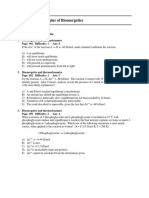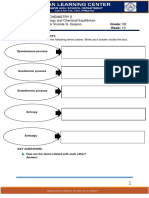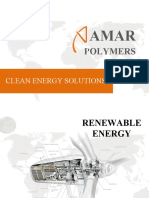Bioenergetics & ATP: After This Section You Should Be Able To
Bioenergetics & ATP: After This Section You Should Be Able To
Uploaded by
Dean ManteCopyright:
Available Formats
Bioenergetics & ATP: After This Section You Should Be Able To
Bioenergetics & ATP: After This Section You Should Be Able To
Uploaded by
Dean ManteOriginal Description:
Original Title
Copyright
Available Formats
Share this document
Did you find this document useful?
Is this content inappropriate?
Copyright:
Available Formats
Bioenergetics & ATP: After This Section You Should Be Able To
Bioenergetics & ATP: After This Section You Should Be Able To
Uploaded by
Dean ManteCopyright:
Available Formats
Bioenergetics & ATP
(Ch. 1.3, 13.1, 13.3)
After this section you should be able to:
Predict the direction of a chemical reaction under standard
conditions based on G
o
or K
eq
Calculate G under non-standard directions
Describe the factors that alter the G of a reaction
Calculate the G of a coupled reaction
Describe what happens when a reaction is in equilibrium
Distinguish factors that influence the direction of a reaction
from factors that influence rate of the reaction
2 Questions for a Chemical Reaction
1) In which direction will it proceed?
2) At what rate will it proceed?
+
Group Activity
Spontaneous
Nonspontaneous
+G
-G
Slow
Fast
Will proceed to the left
Will proceed to the right
Energetically Favorable
Energetically Unfavorable
Endergonic
Exergonic
Determine which of these words
correctly describe each graph to the left?
1) How is the G and equilibrium related to the
direction of a reaction?
2) How can unfavorable reactions be made favorable?
3) Why is ATP so full of energy?
Three Main Questions:
1. Determining rxn direction:
equilibrium & G
H: reflects that number of kinds of bonds in the
reactants and products
S: randomness / disorder of the system
G: free energy change
- G: _______________
+ G: _______________
G represents the free energy change
G = H - TS
All reactions proceed spontaneously
toward lower free energy (-G)
G is independent of reaction path
A+B
C+D A+B
C+D
A + B
A + B
A + B
C + D
C + D
C + D
G = G
products
- G
reactants
How do we calculate G?
G = G+ RT ln
[C]
c
[D]
d
[A]
a
[B]
b
G= -RT ln K
eq
How do we determine G
o
?
Unique constant for each reaction: the driving force
toward equilibrium
How do we define the point of equilibrium?
Determined under standard conditions (
o
):
298 K (25C)
All reactants start at 1M
All products start at 1 M
pH = 7
aA + bB <-----> cC + dD
K
eq
= [C]
c
[D]
d
[A]
a
[B]
b
How do we determine K
eq
?
G= -RT ln K
eq
eq eq
eq eq
Clicker/Group Question
Part 1: For the above reaction the equilibrium concentrations are:
[Glucose] = 5 mM; [P
i
] = 1 mM; [Glucose 6-phosphate] = 18.5 M
What is the value of G? Will this reaction proceed under
standard conditions?
a) G = -13.8 kJ/mol; yes it will proceed
b) G = +13.8 kJ/mol; yes it will proceed
c) G = 0; no, this reaction is at equilibrium
d) G = -13.8 kJ/mol; no it will not proceed
e) G = +13.8 kJ/mol; no it will not proceed
Part 2: Brainstorm with your neighbors: what can be altered to
make this reaction more favorable?
+
Standard conditions arent actual conditions
How do Actual Conditions Differ?
G = G
o
+ RT ln
[C]
c
[D]
d
[A]
a
[B]
b
Concentrations of [A], [B], [C], and [D]
differ from the standard 1M
G = G + RT ln Q
2. How can unfavorable
reactions be made favorable?
1.
Dihydroxyacetone phosphate <--------------> glyceraldehyde 3-phosphate
nutrients
waste
G
o
= +7 kJ/mol
1M
G = ?
1M
10 mM
0.1 mM
2.
+
G(kJ/mol)
+13.8 kJ/mol
-30.5 kJ/mol
ATP ADP +
Glycolysis Under Actual Conditions
3. Why is ATP so full of
energy?
Reactant instability
Product stablility
Value of Q
ATP hydrolysis is exergonic
ATP provides energy by group transfers
Questions
What happens if a molecule has a higher energy of
hydrolysis than ATP for phosphoryl groups?
What special ability would these molecules have?
Phosphoryl-group Transferability
You might also like
- Lehninger Test Bank 13Document14 pagesLehninger Test Bank 13Hina Batool100% (3)
- Fallen AngelDocument3 pagesFallen AngelDean ManteNo ratings yet
- Advanced Temperature Measurement and Control, Second EditionFrom EverandAdvanced Temperature Measurement and Control, Second EditionNo ratings yet
- 5th Edition Free Study Guide For The NASM CPT Exam PDFDocument48 pages5th Edition Free Study Guide For The NASM CPT Exam PDFDean Mante100% (2)
- 1107ex Om PDFDocument120 pages1107ex Om PDFJUNA RUSANDI S100% (2)
- Sterling Test Prep College Physics Practice Questions: Vol. 2, High Yield College Physics Questions with Detailed ExplanationsFrom EverandSterling Test Prep College Physics Practice Questions: Vol. 2, High Yield College Physics Questions with Detailed ExplanationsNo ratings yet
- ws14 1Document6 pagesws14 1Evilasio CostaNo ratings yet
- Chemical Equilibrium Multiple Choice QuestionsDocument4 pagesChemical Equilibrium Multiple Choice QuestionsCarol Mae Celis89% (9)
- O Level Biology Practice Questions And Answers EnzymesFrom EverandO Level Biology Practice Questions And Answers EnzymesRating: 5 out of 5 stars5/5 (1)
- 11 2 Equilibrium - JobsDocument23 pages11 2 Equilibrium - Jobsapi-182809945No ratings yet
- Biochem Chapter Bioenergetics MCQDocument14 pagesBiochem Chapter Bioenergetics MCQGeorges Bi100% (2)
- Paper: Chemistry:: Chemistry MCQ: Chemical KineticsDocument10 pagesPaper: Chemistry:: Chemistry MCQ: Chemical KineticsShakeel AhmadNo ratings yet
- C CC CDocument9 pagesC CC CAkhil KhannaNo ratings yet
- Asdfghjkl GENERALCHEMDocument7 pagesAsdfghjkl GENERALCHEMfai hinchingNo ratings yet
- Lecture 2 - BioEnergeticsDocument16 pagesLecture 2 - BioEnergeticsMkhahlelwaNo ratings yet
- Rough Schedule:: Questions? Please Ask Along The Way!Document49 pagesRough Schedule:: Questions? Please Ask Along The Way!Vivian PhamNo ratings yet
- CHEM 178 Stauffer Chelsea Practice Multiple Choice Exam 1 - KeyDocument5 pagesCHEM 178 Stauffer Chelsea Practice Multiple Choice Exam 1 - KeyWillie SalimNo ratings yet
- Biochem1 2021 (Compatibility Mode)Document26 pagesBiochem1 2021 (Compatibility Mode)Ramsha ShahidNo ratings yet
- ws14 1Document6 pagesws14 1Evilasio CostaNo ratings yet
- TermDocument3 pagesTermNorman Ahmad RiyandiNo ratings yet
- ws14 1Document6 pagesws14 1Diana Jean Alo-adNo ratings yet
- Chm111 by Clever-BDocument7 pagesChm111 by Clever-Bj9927091No ratings yet
- Chapter 5 Chemical Kinetics - ExercisesDocument7 pagesChapter 5 Chemical Kinetics - Exercisestran huyNo ratings yet
- Entropy, Enthalpy, and Free Energy: MaterialsDocument4 pagesEntropy, Enthalpy, and Free Energy: Materialsvinkumar_hbtiNo ratings yet
- CHEM 178 Stauffer Chelsea Practice Multiple Choice Exam 1 - KeyDocument4 pagesCHEM 178 Stauffer Chelsea Practice Multiple Choice Exam 1 - KeyTristan PereyNo ratings yet
- Test PaperDocument4 pagesTest PaperAnonymous doCtd0IJDNNo ratings yet
- Glycogen Found In-: The Goals of This Lesson o o o Bioenergetics and ThermodynamicsDocument24 pagesGlycogen Found In-: The Goals of This Lesson o o o Bioenergetics and ThermodynamicsRuhulAminNo ratings yet
- Testbank 4e CH13Document12 pagesTestbank 4e CH13lanndoan100% (6)
- CHEM 1212 202002 Exam 1 Form A KeyDocument7 pagesCHEM 1212 202002 Exam 1 Form A KeyHamza AhmedNo ratings yet
- U12 Rev Ws - 10 - No Ice or KSPDocument3 pagesU12 Rev Ws - 10 - No Ice or KSPetud3clNo ratings yet
- Chemical Principles 7th Edition Zumdahl Test Bank 1Document20 pagesChemical Principles 7th Edition Zumdahl Test Bank 1jessica100% (58)
- Class XI Equilibrium NotesDocument8 pagesClass XI Equilibrium NoteseasaNo ratings yet
- Classnotesmit - Lecture-7-Biochemical PathwaysDocument7 pagesClassnotesmit - Lecture-7-Biochemical PathwaysHarsha Lodha SethiyaNo ratings yet
- Lecture 5 ThermodynamicsDocument54 pagesLecture 5 Thermodynamicsnena singhNo ratings yet
- Which One Is False For Catalysts?Document2 pagesWhich One Is False For Catalysts?Nurul Kurniati RahayuNo ratings yet
- Chemistry Pre-U Chemistry Sem 1 Chap 5 PDFDocument85 pagesChemistry Pre-U Chemistry Sem 1 Chap 5 PDFJIANHUI0160% (1)
- Biochemistry: Julius P. Mario, RMT, MsciDocument44 pagesBiochemistry: Julius P. Mario, RMT, MsciApril Marie AlcazarenNo ratings yet
- CHM 101 (Chemical Equilibrium) - 1Document15 pagesCHM 101 (Chemical Equilibrium) - 1johnsonndukwe37No ratings yet
- Chapter-6 Chemical-Equilibrium ExercisesDocument8 pagesChapter-6 Chemical-Equilibrium Exercisestran huyNo ratings yet
- Rates of Reaction TestDocument10 pagesRates of Reaction TestSaya MenangNo ratings yet
- Directions: Define The Following Terms Below. Write Your Answer Inside The BoxDocument5 pagesDirections: Define The Following Terms Below. Write Your Answer Inside The BoxLaika LaiNo ratings yet
- ws14 3Document5 pagesws14 3Irish MercadoNo ratings yet
- Chapter 11Document12 pagesChapter 11JeromeNo ratings yet
- Unit 15 - Reaction Rates and EquilibriumDocument68 pagesUnit 15 - Reaction Rates and EquilibriumGarett Berumen-RoqueNo ratings yet
- STPM Form 6Document2 pagesSTPM Form 6ramaramafarahNo ratings yet
- Bioprocess Engineering Principles (Second Edition) - Chapter 12Document105 pagesBioprocess Engineering Principles (Second Edition) - Chapter 12Jhoan SierraNo ratings yet
- Section 18 2 Fill-In NotesDocument2 pagesSection 18 2 Fill-In Notesapi-267321196No ratings yet
- Topic 7Document9 pagesTopic 7Michelle EnkhsaikhanNo ratings yet
- Gibbs Free EnergyDocument6 pagesGibbs Free Energysonicsprint3452No ratings yet
- Gcse Chemistry: UNIT 2.4: FactfileDocument7 pagesGcse Chemistry: UNIT 2.4: FactfileClaresta TjandraNo ratings yet
- Gen Chem 2 Quarter 4 Module 2 (Colored) PDFDocument16 pagesGen Chem 2 Quarter 4 Module 2 (Colored) PDFAndry Eloise JacaNo ratings yet
- Physical Sciences/P2: Exam Revision Tut10Document32 pagesPhysical Sciences/P2: Exam Revision Tut10Thabelo NgwenyaNo ratings yet
- Answersheet 2nd Quarter W2 (Chemistry 2)Document4 pagesAnswersheet 2nd Quarter W2 (Chemistry 2)secret maskNo ratings yet
- Chem HW SolutionsDocument22 pagesChem HW Solutionsabdulrehman786100% (1)
- Chemistry 132 NT: Nothing Great Was Ever Achieved Without EnthusiasmDocument50 pagesChemistry 132 NT: Nothing Great Was Ever Achieved Without Enthusiasmlorraine_cuaNo ratings yet
- 02A Review QuestionsDocument2 pages02A Review QuestionsChris LinNo ratings yet
- General Organic and Biological Chemistry 2nd Edition Janice Gorzynski Smith Test Bank 1Document36 pagesGeneral Organic and Biological Chemistry 2nd Edition Janice Gorzynski Smith Test Bank 1amynash23052000xne100% (44)
- Equilibrium NotesDocument12 pagesEquilibrium NotesalchimaNo ratings yet
- College Organic Chemistry Semester II: Practice Questions with Detailed ExplanationsFrom EverandCollege Organic Chemistry Semester II: Practice Questions with Detailed ExplanationsNo ratings yet
- Chemical Reaction Kinetics: Concepts, Methods and Case StudiesFrom EverandChemical Reaction Kinetics: Concepts, Methods and Case StudiesNo ratings yet
- Physical and Chemical Equilibrium for Chemical EngineersFrom EverandPhysical and Chemical Equilibrium for Chemical EngineersRating: 5 out of 5 stars5/5 (1)
- UntitledDocument418 pagesUntitledDean ManteNo ratings yet
- Request For Police Clearance Certificate: Form #461 Photo Requirement SheetDocument2 pagesRequest For Police Clearance Certificate: Form #461 Photo Requirement SheetDean ManteNo ratings yet
- Haq 10125139 ThesisDocument269 pagesHaq 10125139 ThesisDean ManteNo ratings yet
- Homeworkout ReadyDocument20 pagesHomeworkout ReadyDean ManteNo ratings yet
- QT WriteACoverLetterDocument2 pagesQT WriteACoverLetterDean ManteNo ratings yet
- Hpscan 20221006221104578 2022-10-06 221152138Document1 pageHpscan 20221006221104578 2022-10-06 221152138Dean ManteNo ratings yet
- Inazo Nitobe - Bushido, The Soul of Japan-MobileReference (2010)Document122 pagesInazo Nitobe - Bushido, The Soul of Japan-MobileReference (2010)Dean ManteNo ratings yet
- Shiki No Uta - Samurai ChamplooDocument5 pagesShiki No Uta - Samurai ChamplooDean ManteNo ratings yet
- SenbonzakuraDocument6 pagesSenbonzakuraDean ManteNo ratings yet
- Shika No Uta (Samurai Champloo ED)Document5 pagesShika No Uta (Samurai Champloo ED)Dean ManteNo ratings yet
- Here's How The Essay Question Will Be Evaluated. The Essay WriterDocument1 pageHere's How The Essay Question Will Be Evaluated. The Essay WriterDean ManteNo ratings yet
- Watamote Watashi Ga Motenai No Wa Dou Kangaete Mo Omaera Ga WaruiDocument5 pagesWatamote Watashi Ga Motenai No Wa Dou Kangaete Mo Omaera Ga WaruiXavier PabellonNo ratings yet
- Abnormal Behavior and The Law What Is Abnormal Behavior?: Nevid, Rathus, & Greene)Document7 pagesAbnormal Behavior and The Law What Is Abnormal Behavior?: Nevid, Rathus, & Greene)Dean ManteNo ratings yet
- Coolant and Your EngineDocument78 pagesCoolant and Your Enginedummy account100% (1)
- Dynamic Energy and Mass Balance Model For An Industrial Alkaline Water Electrolyzer Plant ProcessDocument18 pagesDynamic Energy and Mass Balance Model For An Industrial Alkaline Water Electrolyzer Plant ProcessLucas Vander MeyNo ratings yet
- Directors ReportDocument51 pagesDirectors ReportEllis ElliseusNo ratings yet
- Joystick PositionDocument8 pagesJoystick PositionLiebherrNo ratings yet
- Polymers: Clean Energy SolutionsDocument22 pagesPolymers: Clean Energy SolutionsbalaNo ratings yet
- Enerpac - Bombas Air Hidraulicas Modelo PADocument1 pageEnerpac - Bombas Air Hidraulicas Modelo PAHidroil Neuquen SrlNo ratings yet
- Daikin Parallel Fan Powered VAV Systems AppGuide AG 31-018 LRDocument2 pagesDaikin Parallel Fan Powered VAV Systems AppGuide AG 31-018 LRSambhav TiwariNo ratings yet
- Microjet Recorder E: Instruction ManualDocument99 pagesMicrojet Recorder E: Instruction ManualkmpoulosNo ratings yet
- Letter Regarding 4E Energy ConservationDocument3 pagesLetter Regarding 4E Energy ConservationMohd FarhanNo ratings yet
- Power Quality: Project ON Grid Connected PV SystemsDocument22 pagesPower Quality: Project ON Grid Connected PV SystemsRahul Radhakrishnan100% (1)
- Che0405 Ped Lecture 1Document25 pagesChe0405 Ped Lecture 1miraNo ratings yet
- Hydrophobic, Antireflective, Self Cleaning, and Antifogging Sol Gel Coatings An Example of Multifunctional Nanostructured Materials For Photovoltaic Cells 2010 Chemistry of MaterialsDocument8 pagesHydrophobic, Antireflective, Self Cleaning, and Antifogging Sol Gel Coatings An Example of Multifunctional Nanostructured Materials For Photovoltaic Cells 2010 Chemistry of MaterialsEsau AguillónNo ratings yet
- Trip Settings NSX Micrologic 2 Circuit BreakerDocument4 pagesTrip Settings NSX Micrologic 2 Circuit BreakerMekaNo1D100% (3)
- D0D009BCd01-Saltmaster ManualDocument4 pagesD0D009BCd01-Saltmaster ManualGeoff DavisNo ratings yet
- Example 3: SolutionDocument4 pagesExample 3: SolutionAlejandra SanchezNo ratings yet
- MUGHEERADocument6 pagesMUGHEERA20pwmin0871No ratings yet
- Basic Electrical Engineering: by Dr. G. RameshDocument97 pagesBasic Electrical Engineering: by Dr. G. Rameshnaman jaiswalNo ratings yet
- Siemens Sinamics V20 Getting StartedDocument34 pagesSiemens Sinamics V20 Getting StartedRolando QuirozNo ratings yet
- Industrial Enterprises Inc V CA DigestDocument2 pagesIndustrial Enterprises Inc V CA DigestTeodoro Jose BrunoNo ratings yet
- Mobile Xray AceMobil-510V - Catalogue enDocument2 pagesMobile Xray AceMobil-510V - Catalogue enWael Fuad AL-MaktariNo ratings yet
- Ey GL Ifrs Devel227 Contracts For Renewable Energy 05 2024Document4 pagesEy GL Ifrs Devel227 Contracts For Renewable Energy 05 2024Kaiimook SaisuwanNo ratings yet
- S08 Diesel Power PackDocument174 pagesS08 Diesel Power PackElizabeth OctagonNo ratings yet
- Chiller 1Document5 pagesChiller 1Wiro SablengNo ratings yet
- SSP 25 Octavia ClimatronicDocument42 pagesSSP 25 Octavia Climatronicahmedsalehawad100% (1)
- ABSTRACT AmshaDocument8 pagesABSTRACT AmshagovindhanNo ratings yet
- ABB Low Voltage Surge Arrester PDFDocument8 pagesABB Low Voltage Surge Arrester PDFrajpre1213No ratings yet
- KS 1876-2-2010 Overhead Power Lines For Kenya - Safety PDFDocument33 pagesKS 1876-2-2010 Overhead Power Lines For Kenya - Safety PDFKy TaNo ratings yet
- FPTS 120L & 150L & 200L & 300L Thermosiphon Systems: Installation ManualDocument24 pagesFPTS 120L & 150L & 200L & 300L Thermosiphon Systems: Installation ManualZain ShariffNo ratings yet
- An Accurate Two-Node Finite Element For Shear Deformable Curved BeamsDocument26 pagesAn Accurate Two-Node Finite Element For Shear Deformable Curved BeamsNebojsa MitrovicNo ratings yet








































































































